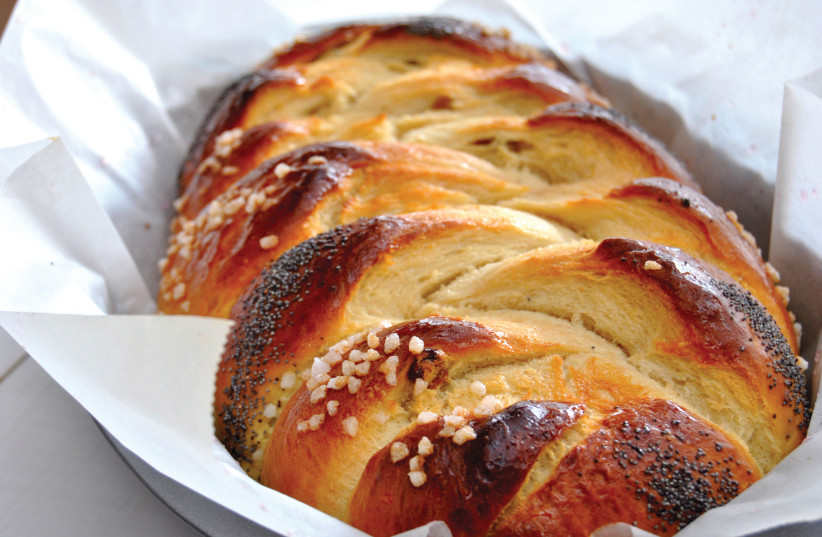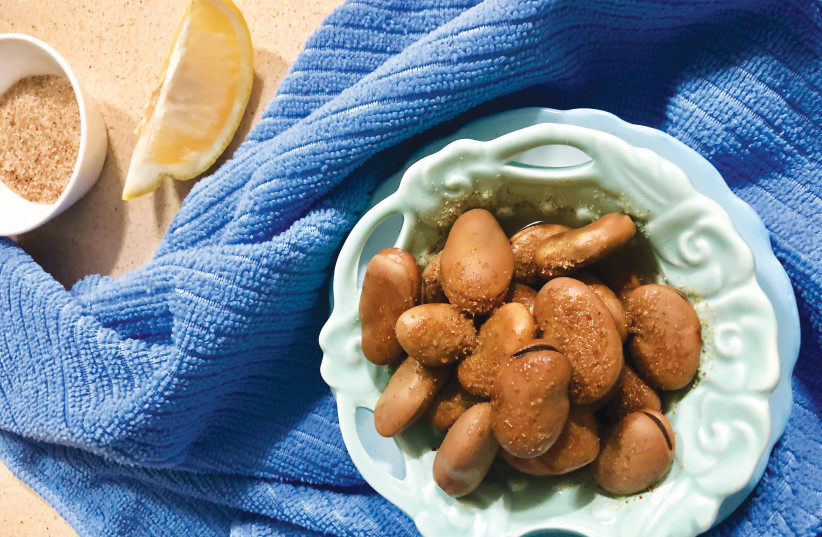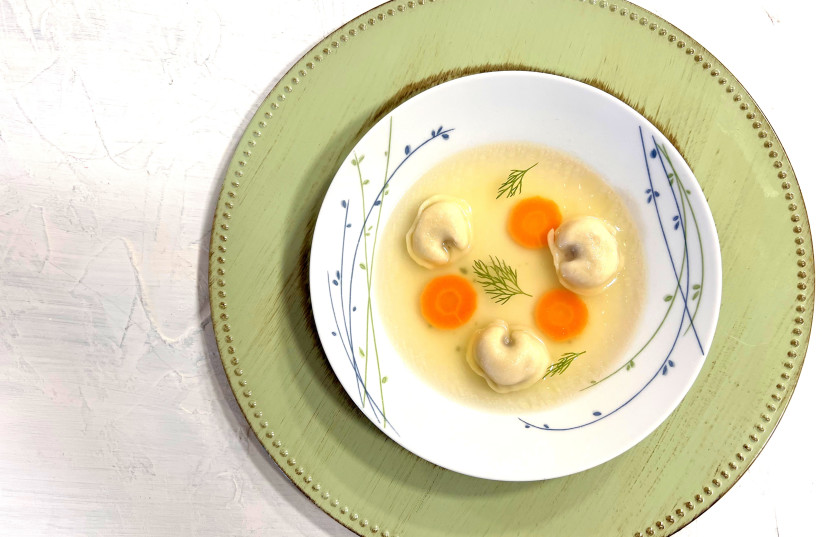“When Adar begins, we increase our happiness,” the Talmud teaches us, and this is certainly true for me when I begin my preparations for Purim each year.
“When Adar begins, we increase our happiness.”
Talmud
I love getting all the costumes ready and holding parties, but the part of Purim that I love more than any other is preparing for the annual Purim seuda (feast), when we gather together with family members, admire each other’s costumes and bring each other mishloah manot (gifts of food).
When I was a child, we began our Purim seuda with ful (fava beans) that were soaked overnight, then cooked in water with a little lemon, and served with salt and cumin.
The next course was ma’akuda, a quiche that can be made in a number of ways: with carrots, potatoes, beef, chicken or eggs.
The main dish was stuffed chicken cooked with cinnamon, which is served with a side dish of muluyiha.

We didn’t eat hamentashen for dessert. Instead, we ate special Tunisian Purim cookies such as debla, yoyo and markud, which were covered in a perfumed syrup.
In Ashkenazi cuisine, the Purim seuda usually includes chicken soup with kreplach (dumplings).
Kreplach are traditionally eaten on three different occasions in the Jewish calendar: just before the Yom Kippur fast, since we use our fists to pound on our hearts as we ask God for forgiveness during the holiday prayers; on Hoshana Raba, when we take the willow branches and strike the ground with them; and on Purim while reading Megillat Esther, when we stamp our feet each time we hear Haman’s name.
Kreplach can be filled with beef, chicken, buckwheat, potato or liver; or, if you want to make them vegetarian, with lentils and other beans or fruit. On Purim, they are traditionally made with beef or fruit.
While doing research on kreplach, I came across dozens of recipes, all of which are amazing. Below, I bring you the one I like the best.
One of the most well-known recipes for Purim that hails from Morocco is boyos di Purim, challot made with raisins and almonds, which are baked with whole hard-boiled eggs. Some people make one large challah in the shape of a crown, and other people make lots of small challot with an egg in the center, which they can send in their mishloah manot.
The way to make sure the hard-boiled egg stays in place during baking is by taking two thin strips of dough and placing them over the top of the egg in the form of an X, which straps them into place. These eggs symbolize Haman’s evil eye, and ripping the egg off of the bread is like ripping out the eyes of the evil villain. Rolls made with eggs are also found in Spanish Sephardi cuisine.
In Polish Jewish cuisine, it is customary to bake a keylitsch challah. The strips of the challah symbolize the ropes that were used to hang Haman and his sons. The same recipe is used to make little rolls called braches, i.e., blessings.
In short, it’s amazing to see how each Jewish community around the world has special recipes for meals and desserts that are traditionally prepared for Purim: ful (fava beans) with cumin, kreplach, boyos di Purim and keylitsch.
KEYLITSCH PURIM CHALLAH
Makes 2 large challot or 15-20 challah rolls.
- 500 gr. flour, sifted
- 50 gr. fresh yeast
- 5 Tbsp. oil
- ¾ cup light raisins
- 3 eggs
- Pinch of salt
- ¾ cup sugar
- 2 Tbsp. vanilla sugar
- 2 Tbsp. lemon zest
- 1½-2 cups water
Egg wash:
- 1 beaten egg + tsp. oil + ½ tsp. syrup
Toppings:
- 50 gr. whole poppy seeds
- 50 gr. colored sprinkles or crystal sugar
Add the flour to a large bowl. Sprinkle the yeast on the flour.
In a separate bowl, mix together the oil, raisins, eggs, salt, sugar, vanilla sugar and lemon zest.
Make a well in the center of the flour, pour the egg mixture into it and knead. Gradually add the water while kneading the dough. Knead until mixed well.
Cover the bowl with plastic wrap and place it in a warm place to rise for 90 minutes until the dough doubles in volume.
Separate the dough into 2 sections. Then, separate each section into 3 equal pieces. Roll out each piece into a strip with a diameter of 3-4 centimeters. Connect the three strips together at one end, then braid the strips. Make the second challah in the same fashion.
Line a tray with baking paper or grease it. Place the challot on the tray and let them rise another 30 minutes. Brush them with the egg wash, then sprinkle poppy seeds, sprinkles and crystal sugar on top.
Bake in an oven that has been preheated to 180° for 25-30 minutes.
Level of difficulty: Medium
Time: 2.5-3 hours
Status: Parve
BOYOS DI PURIM CHALLAH
Makes 3-4 large challot or 8-10 small challot.
- 60 gr. fresh yeast
- ½ cup lukewarm water
- 1 kg. flour, sifted
- 3 Tbsp. sesame seeds
- 1 cup sugar
- 1¼ cups walnuts or pecans, coarsely chopped
- ¼ tsp. salt
- 4 eggs
- 2 cups water
- 8 Tbsp. oil
- 4-6 hard-boiled eggs
- 2 egg yolks, beaten with ½ tsp. sugar
- 1 cup peeled almonds
Dissolve the yeast in a half cup of lukewarm water. Sprinkle with a little flour, cover it, and set it aside to ferment.
Place the flour in the bowl of an electric mixer. Add the sesame seeds, sugar, nuts and salt. Mix on low speed, then add the eggs and the yeast mixture. While kneading the dough, gradually add the water and oil. Mix well.
Cover the bowl and put it in a warm place for 2 hours or until the dough doubles in volume.
Separate the dough into 3 equal sections. Roll each piece into a ball. Take a bit of dough from each section and set aside. Shape each section into a ring.
On the outer edge of the challah, make diagonal cuts that are 4 centimeters deep and 4 centimeters from each other, in a zigzag design. One cut will be in one direction, then the next cut in the opposite direction, all the way around the challah.
Create 2 or 3 deep indentations in the challah, and place a hardboiled egg in each one.
From the small pieces of dough that you set aside, roll out thin strips, then place two of them across the top of each egg in the shape of an X to hold them in place.
Make the other challot in the same way. Let the challot rise for another 20 minutes.
Brush each challah with the egg wash, then sprinkle almonds on top. Line a tray with baking paper and place the challot on it, with space between each one. Bake in an oven that has been preheated to 180° for 25-35 minutes.
Level of difficulty: Easy-medium
Time: 4 hours, including time to let the dough rise
Status: Parve

FUL (FAVA BEANS) WITH CUMIN
Makes 8 servings.
- 3 cups dried fava beans, soaked in water overnight, then drained. Or fresh green fava beans, peeled
- 1 large lemon, quartered
Serving suggestion:
- 1 tsp. salt
- ½ tsp. ground cumin
Cook the fava beans in water with the lemon for 1 hour until they’ve softened. Mix the salt with the cumin in a small bowl.
Serve the fava beans while they’re still hot in individual bowls or on a serving platter. Sprinkle salt and cumin on top.
Level of difficulty: Easy
Time: 40 minutes (not including soaking time)
Status: Parve

KREPLACH (DUMPLINGS)
Makes 6-8 servings.
Dough:
- 2 cups flour, sifted (or 1 cup durum flour and 1 cup white flour)
- 1 egg
- 2 tsp. oil
- ¼-½ cup water
- ½ tsp. salt
Egg wash:
- 1 egg yolk or 1 egg, beaten
Filling:
- 3-4 Tbsp. oil
- 2 onions, chopped
- ¾-1 cup cooked ground beef
- ½ tsp. salt
- ½ tsp. pepper
- 1 egg
- 1 tsp. sugar
- ½ Tbsp. bread crumbs
To prepare the dough: Place all the dough ingredients in a food processor and mix until smooth. The dough should be flexible and easy to manipulate. If it’s not soft enough, you can add another teaspoon or two of water, and knead the dough by hand. Let the dough rest for an hour in the fridge.
To prepare the filling: Heat the oil in a large frying pan and sauté the onions until they turn translucent. Add the ground beef and stir, breaking up all the pieces. Then, transfer mixture to a bowl and let it cool down. Add the other ingredients and mix well.
To put the kreplach together: Flour your work surface, then roll out the dough until it is very thin. Cut out circles with a small glass. Brush some of the egg wash on the edge of the circle, then take a little filling and place it in the center of the circle. Then, fold over one side of the circle and press it down into the other side and press to close, making a half circle. Make sure there are no openings; otherwise, the filling will fall out.
Next, take both ends of the kreplach and bring them together and press to connect. This is the final shape of the kreplach. Follow the same method to make the rest of the kreplach.
To cook the kreplach: Boil water in a pot with salt as you would to make pasta. Once the water boils, gently add the kreplach to the pot.
Once the kreplach have popped up and are floating on top of the water, cook them another 3 minutes. Add a glass of cold water to the pot to stop the kreplach from cooking. Remove the kreplach from the water with a slotted spoon and place them on an oiled plate. Cook all the kreplach in the same fashion.
Serve the kreplach in chicken soup, with a meat sauce, or with fried onion and olive oil.
Level of difficulty: Medium
Time: 90 minutes
Status: Meat
Translated by Hannah Hochner.
